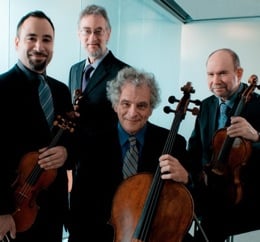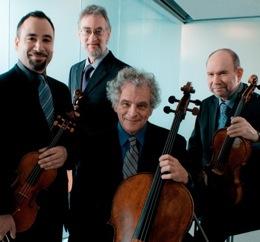
The Juilliard Quartet weathered its last change of leaders unusually smoothly, since the new first, Joel Smirnoff, was already in the quartet (as second violinist). With Smirnoff’s departure to head the Cleveland Institute of Music, Nick Eanet, for the last decade the concertmaster of the Metropolitan Opera Orchestra, has taken his place. The ensemble’s San Francisco Performances–presented recital Sunday evening at Herbst Theatre, part of the quartet’s first tour with Eanet, afforded an opportunity to see how well the transplant took. I’d say the preliminary prognosis is good.
The program’s bookends were paired early-Romantic stalwarts: Mendelssohn’s D-Major Quartet (Op. 441/1) to open, Schumann’s A-Major (Op. 41/3) to close. Both reacted well to the meaty Juilliard approach, though in different ways. With the Mendelssohn, the great pleasure was in the physical gutsiness of the outer movements. This is music grounded in the plain fun of playing it, of being borne along in the sheer rush of its kinetic energy. The finale, especially, is all about momentum; every dash back into the main theme is like a triumphant sprint over the crest of a hill. Eanet reveled in the nonstop activity of his part, seemingly tireless, and his elder colleagues goaded him on magnificently.
There were, it’s true, times when the bald muscularity of the playing came to seem a shade unrelenting. This is not altogether the players’ fault — both outer movements have long stretches at forte or above — still, I’ve heard other ensembles manage to insinuate a bit more contrast. But the places that really need to be hushed were all the more marvelous by contrast. The mysterious little F-sharp-minor pianissimo passage in the first movement was arresting, and both inner movements shone in rich though veiled colors.
To the Schumann, a work more insistently passionate, the Juilliards brought a depth of tone and a wealth of inflection that suited the music exceedingly well. There is a complexity of texture in a group with a history as long and layered as this one’s. You can hear, as it were, the generations mingling; it’s a little like being able to pick out the individual spices in a sauce while also tasting the blend as a blend.
There are sounds in the current Juilliard blend that I confess to admiring much more as parts of that texture than on their own. Samuel Rhodes, the violist (the ensemble’s senior member, in his 41st year with the ensemble), has a vibrato so slow and so wide that in some of his solo lines it verged on self-caricature. Yet in the ensemble context it was like a viola demi-glace — Essence of Viola, a rich, woody, minutely concentrated timbre that permeated the collective sound.
The cellist, Joel Krosnick, likewise seemed brusque and even ungainly in a few of his solos (I’m thinking particularly of the high-flying second theme of the Schumann’s first movement). But I’ve never heard more sheer authority in a cello bassline. In places like the second movement’s stern last variation, it was a voice that brooked no argument.
Above all this, Eanet fit smoothly and silkily, matching second violinist Ronald Copes well in timbre, and playing with enviable confidence. Eanet’s is no outsize personality like Rhodes’ or Krosnick’s, but this is a most attractive, nimble, and powerful violinist. In comparison to his predecessor, Joel Smirnoff, Eanet struck me Sunday as lighter-toned and more refined of articulation, but not strikingly so. At any rate, he fit into Smirnoff’s place with almost audacious ease.
Daunting Challenge Well Met
Between Mendelssohn and Schumann came Mario Davidowsky’s 1998 String Quartet No. 5. Starting a tour with such a demanding work might seem a rather formidable task for a quartet to set its new first violinist. But Eanet was once first violinist of the Mendelssohn String Quartet, for whom the work was written, so I imagine he came by his easy familiarity with the score the old-fashioned way.Certainly he, like his colleagues, knew the daunting piece inside and out. The quartet is subtitled Denk an Op. 132 — the “Op. 132” being Beethoven’s A-Minor Quartet, from whose great central “Heiliger Dankgesang” (Sacred song of thanksgiving) the work draws its motivic material. And not much else: If you know the Beethoven, you can hear the connection, especially in the rising sixth that opens both pieces and recurs through both, but there’s nothing in the Davidowsky, thank goodness, that aims to duplicate the Beethoven’s unearthly stillness and serenity.
Instead the music is tense, troubled, even when its surface is quiet. There are crepuscular stirrings, rustlings, whistlings; there are great yearning, sighing, slow stretches; there are sudden, spirited, slashing outbursts of activity. Yet, while there’s a great deal happening, it’s nearly always in concert — this isn’t a quartet texture actively warring against itself, as you find in Elliott Carter’s quartets. The ensemble is always picking a path as an ensemble. This is a piece I want to hear again.
The Juilliards played a single encore: a dark-toned, brooding performance of the Minuetto from Schubert’s A-Minor Quartet.

